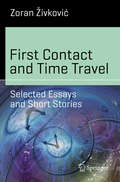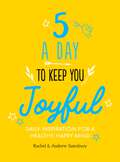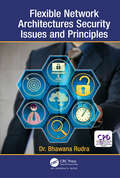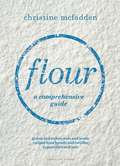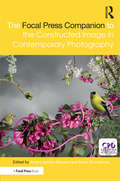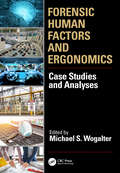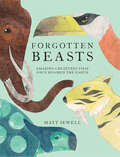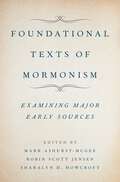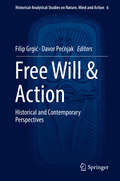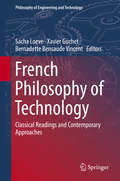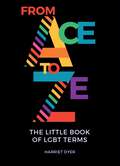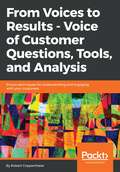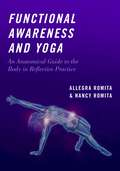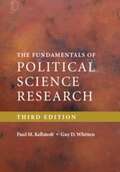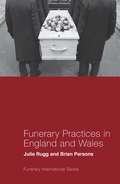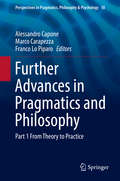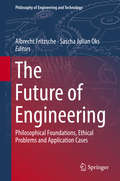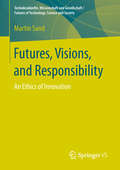- Table View
- List View
First Contact and Time Travel: Selected Essays and Short Stories (Science and Fiction)
by Zoran ŽivkovićThis volume collects both essays and fictional material around two core topics in the long career of the Serbian writer, essayist, researcher, publisher and translator. The first topic - first contact - is chiefly represented by his comprehensive essay on "The Theme of First Contact in the SF Works of Arthur C. Clarke" and reflected on the literary level with his short stories "The Bookshop" and "The Puzzle". Two shorter essays on the second topic - time travel in SF literature - introduce, amongst others, the well-known and fascinating mosaic novel Time Gifts, which skillfully explores the more literary side of the notions of past, present and future. In the annotations the author provides insights into his take on the subjects presented.
Five A Day to Keep You Joyful: Daily Inspiration for a Healthy, Happy Mind
by Andrew Sainsbury Rachel SainsburyEveryone knows it’s good to eat five portions of fruit and veggies a to keep your body in tip-top condition, but what about a five-a-day for your mind? With wise words on the topics of mindfulness, friendship, appreciation, kindness and happiness, this is an inspirational little book that could have a BIG impact on your day.
Flexible Network Architectures Security: Principles and Issues
by Bhawana RudraThe future of Internet security doesn’t lie in doing more of the same. It requires not only a new architecture, but the means of securing that architecture. Two trends have come together to make the topic of this book of vital interest. First, the explosive growth of the Internet connections for the exchange of information via networks increased the dependence of both organizations and individuals on the systems stored and communicated. This, in turn, has increased the awareness for the need to protect the data and add security as chief ingredient in the newly emerged architectures. Second, the disciplines of cryptography and network security have matured and are leading to the development of new techniques and protocols to enforce the network security in Future Internet. This book examines the new security architectures from organizations such as FIArch, GENI, and IETF and how they’ll contribute to a more secure Internet.
Flexible Network Architectures Security: Principles and Issues
by Bhawana RudraThe future of Internet security doesn’t lie in doing more of the same. It requires not only a new architecture, but the means of securing that architecture. Two trends have come together to make the topic of this book of vital interest. First, the explosive growth of the Internet connections for the exchange of information via networks increased the dependence of both organizations and individuals on the systems stored and communicated. This, in turn, has increased the awareness for the need to protect the data and add security as chief ingredient in the newly emerged architectures. Second, the disciplines of cryptography and network security have matured and are leading to the development of new techniques and protocols to enforce the network security in Future Internet. This book examines the new security architectures from organizations such as FIArch, GENI, and IETF and how they’ll contribute to a more secure Internet.
Flour: a comprehensive guide
by Christine McFaddenGrains and pulses, nuts and seeds: recipes from breads and tortillas to pancakes and pies.In this timely new book Christine McFadden explores the way in which flour has been a staple part of our diet, and provides a comprehensive look at the alternatives to traditional wheat flour. With an increasing and at times bewildering choice of flours available online and in shops, this book follows a usable A–Z format, providing a CV of sorts for each flour (including plant source, gluten content, protein content, flavour profile and how best to use). Each of the flours featured is accompanied by suggested recipes from Christine's kitchen, and these recipes demonstrate the often underestimated ways in which flour is used. Flours range from cassava and quinoa to cricket flour and coffee flour, with delicious recipes such as cheddar and chilli cornbread (using amaranth flour), salted chocolate tart with buckwheat and walnut pastry, spicy onion pancakes (using moong dal) and spring lamb pot pies (with tradition plain wheat flour).Recipes are accompanied by beautiful photography to bring the dishes to life.
The Focal Press Companion to the Constructed Image in Contemporary Photography
by Anne Leighton Massoni Marni ShindelmanThis compendium examines the choices, construction, inclusions and exemptions, and expanded practices involved in the process of creating a photograph. Focusing on work created in the past twenty-five years, this volume is divided into sections that address a separate means of creating photographs as careful constructs: Directing Spaces, Constructing Places, Performing Space, Building Images, and Camera-less Images. Introduced by both a curator and a scholar, each section features contemporary artists in conversation with curators, critics, gallerists, artists, and art historians. The writings include narratives by the artist, writings on their work, and examinations of studio practices. This pioneering book is the first of its kind to explore this topic beyond those artists building sets to photograph.
The Focal Press Companion to the Constructed Image in Contemporary Photography
by Marni Shindelman Anne Leighton MassoniThis compendium examines the choices, construction, inclusions and exemptions, and expanded practices involved in the process of creating a photograph. Focusing on work created in the past twenty-five years, this volume is divided into sections that address a separate means of creating photographs as careful constructs: Directing Spaces, Constructing Places, Performing Space, Building Images, and Camera-less Images. Introduced by both a curator and a scholar, each section features contemporary artists in conversation with curators, critics, gallerists, artists, and art historians. The writings include narratives by the artist, writings on their work, and examinations of studio practices. This pioneering book is the first of its kind to explore this topic beyond those artists building sets to photograph.
Forensic Human Factors and Ergonomics: Case Studies and Analyses (Human Factors and Ergonomics)
by Michael S. WogalterThis book has 18 case study chapters investigating various injury scenarios through the use of a Human Factors and Ergonomics (HFE) analysis. Each injury scenario derives from one or more similar lawsuits (but names, places and some of the details are fictionalized). The scenarios describe a ‘slice of life’ of people interacting with products, equipment, tasks, and environments before they are seriously hurt. The forensic analysis that follows each scenario gives a background of prior similar events and systematically examines potential causes leading to the injury event. There is emphasis on the person-machine interface, human error, hazard analysis, hazard control and a model of communication-human information processing (C-HIP). Chapters are authored by highly experienced expert witnesses in HFE. The methods used are general techniques that can be applied to other injury scenarios, but would be better if employed earlier in a product’s life cycle to prevent or limit injury. The first three chapters introduce concepts useful for the analyses in the case study chapters. The last chapter offers some broad take-away points that cut across several of the case studies. Features contributions by persons who have extensive experience in HFE and who have served professionally in the role of an expert witness in various legal cases mostly in product liability Gives a broad range of situations to illustrate where HFE considerations could improve product or environmental safety. There is an emphasis on children/caregivers, and adult activities such as driving Uses mitigation strategies to reduce the likelihood of occurrence and severity of adverse events Includes a first-person scenario at the beginning of each chapter Allows the lessons learned to be adaptable to other domains where people interact with products and environments
Forensic Human Factors and Ergonomics: Case Studies and Analyses (Human Factors and Ergonomics)
by Michael S. WogalterThis book has 18 case study chapters investigating various injury scenarios through the use of a Human Factors and Ergonomics (HFE) analysis. Each injury scenario derives from one or more similar lawsuits (but names, places and some of the details are fictionalized). The scenarios describe a ‘slice of life’ of people interacting with products, equipment, tasks, and environments before they are seriously hurt. The forensic analysis that follows each scenario gives a background of prior similar events and systematically examines potential causes leading to the injury event. There is emphasis on the person-machine interface, human error, hazard analysis, hazard control and a model of communication-human information processing (C-HIP). Chapters are authored by highly experienced expert witnesses in HFE. The methods used are general techniques that can be applied to other injury scenarios, but would be better if employed earlier in a product’s life cycle to prevent or limit injury. The first three chapters introduce concepts useful for the analyses in the case study chapters. The last chapter offers some broad take-away points that cut across several of the case studies. Features contributions by persons who have extensive experience in HFE and who have served professionally in the role of an expert witness in various legal cases mostly in product liability Gives a broad range of situations to illustrate where HFE considerations could improve product or environmental safety. There is an emphasis on children/caregivers, and adult activities such as driving Uses mitigation strategies to reduce the likelihood of occurrence and severity of adverse events Includes a first-person scenario at the beginning of each chapter Allows the lessons learned to be adaptable to other domains where people interact with products and environments
Forgotten Beasts: Amazing Creatures That Once Roamed The Earth
by Matt SewellWhat do you know about the our planet's strangest extinct creatures? Less celebrated than the dinosaurs, these beasts are equally impressive. Enjoy Matt Sewell's characteristic watercolour illustrations and witty, fascinating descriptions of these amazing creatures that once did stalk the planet.
Foundational Texts of Mormonism
by Mark Ashurst-McGee Robin Jensen Sharalyn D. HowcroftJoseph Smith, founding prophet and martyr of the Church of Jesus Christ of Latter-day Saints, personally wrote, dictated, or commissioned thousands of documents. Among these are several highly significant sources that scholars have used over and over again in their attempts to reconstruct the founding era of Mormonism, usually by focusing solely on content, without a deep appreciation for how and why a document was produced. This book offers case studies of the sources most often used by historians of the early Mormon experience. Each chapter takes a particular document as its primary subject, considering the production of a document as an historical event in itself, with its own background, purpose, circumstances, and consequences. The documents are examined not merely as sources of information but as artifacts that reflect aspects of the general culture and particular circumstances in which they were created. This book will help historians working in the founding era of Mormonism gain a more solid grounding in the period's documentary record by supplying important information on major primary sources.
Foundational Texts of Mormonism
by Mark Ashurst-Mcgee, Robin Scott Jensen and Sharalyn D. HowcroftJoseph Smith, founding prophet and martyr of the Church of Jesus Christ of Latter-day Saints, personally wrote, dictated, or commissioned thousands of documents. Among these are several highly significant sources that scholars have used over and over again in their attempts to reconstruct the founding era of Mormonism, usually by focusing solely on content, without a deep appreciation for how and why a document was produced. This book offers case studies of the sources most often used by historians of the early Mormon experience. Each chapter takes a particular document as its primary subject, considering the production of a document as an historical event in itself, with its own background, purpose, circumstances, and consequences. The documents are examined not merely as sources of information but as artifacts that reflect aspects of the general culture and particular circumstances in which they were created. This book will help historians working in the founding era of Mormonism gain a more solid grounding in the period's documentary record by supplying important information on major primary sources.
Free Will & Action: Historical and Contemporary Perspectives (Historical-Analytical Studies on Nature, Mind and Action #6)
by Filip Grgić Davor PećnjakThis book consists of eleven new essays that provide new insights into classical and contemporary issues surrounding free will and human agency. They investigate topics such as the nature of practical knowledge and its role in intentional action; mental content and explanations of action; recent arguments for libertarianism; the situationist challenge to free will; freedom and a theory of narrative configuration; the moral responsibility of the psychopath; and free will and the indeterminism of quantum mechanics. Also tackling some historical precursors of contemporary debates, taken together these essays demonstrate the need for an approach that recognizes the multifaceted nature of free will. This book provides essential reading for anyone interested in the current scholarship on free will.
French Philosophy of Technology: Classical Readings and Contemporary Approaches (Philosophy of Engineering and Technology #29)
by Sacha Loeve Xavier Guchet Bernadette Bensaude VincentOffering an overall insight into the French tradition of philosophy of technology, this volume is meant to make French-speaking contributions more accessible to the international philosophical community. The first section, “Negotiating a Cultural Heritage,” presents a number of leading 20th century philosophical figures (from Bergson and Canguilhem to Simondon, Dagognet or Ellul) and intellectual movements (from Personalism to French Cybernetics and political ecology) that help shape philosophy of technology in the Francophone area, and feed into contemporary debates (ecology of technology, politics of technology, game studies). The second section, “Coining and Reconfiguring Technoscience,” traces the genealogy of this controversial concept and discusses its meanings and relevance. A third section, “Revisiting Anthropological Categories,” focuses on the relationships of technology with the natural and the human worlds from various perspectives that include anthropotechnology, Anthropocene, technological and vital norms and temporalities. The final section, “Innovating in Ethics, Design and Aesthetics,” brings together contributions that draw on various French traditions to afford fresh insights on ethics of technology, philosophy of design, techno-aesthetics and digital studies. The contributions in this volume are vivid and rich in original approaches that can spur exchanges and debates with other philosophical traditions.
Fresh Clean Home: Make Your Own Natural Cleaning Products
by Wendy GrahamRecipes for natural cleaning products from green living blogger Wendy Graham. Learn how to make your home smell as fresh as a daisy with these eco-friendly, money-saving, germ-busting recipes.
From Ace to Ze: The Little Book of LGBT Terms
by Harriet DyerThis easy-to-use dictionary introduces some of the most essential terminology surrounding gender, sexuality and LGBTQIA+ identity. If you have questions about yourself or about the terminology, or even if you’re simply interested in learning more, this essential guide will help you navigate the world with knowledge and kindness.
From Voices to Results - Voice of Customer Questions, Tools and Analysis
by Robert CoppenhaverMake the right decisions about your products and services by listening effectively to the people that matter – your customers Key Features Understand the core components, processes and technologies available for a VOC initiative Structure effective VOC programs and turn VOC into actionable product success A handy guide to help you identify the hidden needs of your customers and strengthen your relationship with them Book Description Voice of Customer (VoC) is one of the most popular forms of market research that combines both quantitative and qualitative methods. This book is about developing a deeper knowledge of your customers and understanding their articulated and unarticulated needs. Doing so requires engaging with customers in a meaningful and substantive way – something that is becoming more and more important with the rise of the increasingly connected world. This book gives you a framework to understand what products and features your customers need, or will need in the future. It provides the tools to conduct a VoC program and suggests how to take the customer input and turn it into successful products. This book also explains how to position and price your products in the market, and demonstrates ROI to the management team to get your product development funded. By the end of this book, you will have a thorough understanding of the relevant stages of a VoC project. It will show you how to devise an effective plan, direct the project to their objectives, and then how to collect the voice of the customer, with examples and templates for interviewing and surveying them. What you will learn Learn why customer input is so critical for the product's success Discover the articulated and unarticulated needs of your customers Deploy an effective VoC program in your organization Learn which tools and methods you need to set up a successful VoC program Interview customers – where, how many, and who Create an interview guide and roles in the interview process Translate the customer input into your product specifications Integrate VoC into your marketing campaigns and pricing process Who this book is for The book is for anyone who needs to get to know their customer, how they feel and what they think about a certain subject. If you are a stakeholder in any project responsible for customer relationships, this book will help you immensely. An awareness of VOC as a topic would be useful, although not essential.
FUNCTIONAL AWARENESS & YOGA C: An Anatomical Guide to the Body in Reflective Practice
by Nancy Romita Allegra RomitaFunctional Awareness and Yoga is an essential book for all who wishes to deepen their yoga practice and discover strategies to reduce strain or discomfort on the mat as well as in daily life. It is also an excellent book of introductory concepts in anatomy as applied to yoga required during a yoga teacher training. Each chapter provides essentials in functional anatomy with over 60 practical illustrations. The chapters also apply specific postures in yoga with cues to support the practice on the mat. Finally, each chapter contains a mindful practice section to help readers integrate anatomical imagery into daily life in order to release unnecessary tension, improve posture, and support ease of movement. The reflective practice of Functional Awareness® changes how one goes through simple daily tasks in living and demonstrates how these small simple shifts can have a profound effect on ease in action and resilience in movement both on and off the yoga mat. Guiding readers through the essentials in body alignment by providing engaging explorations in body/mind awareness, the book offers a pathway to improve resilience and balance in action.
The Fundamentals Of Political Science Research (PDF)
by Paul M. Kellstedt Guy D. WhittenThe third edition of the best-selling The Fundamentals of Political Science Research provides an introduction to the scientific study of politics. It offers the basic tools necessary for readers to become both critical consumers and beginning producers of scientific research on politics. The authors present an integrated approach to research design and empirical analyses whereby researchers can develop and test causal theories. They use examples from political science research that students will find interesting and inspiring, and that will help them understand key concepts. The book makes technical material accessible to students who might otherwise be intimidated by mathematical examples. This revised third edition features new 'Your Turn' boxes meant to engage students. The edition also has new sections added throughout the book to enhance the content's clarity and breadth of coverage.
Funerary Practices in England and Wales (Funerary International)
by Julie Rugg Brian ParsonsThe Funerary International series comprises essential reference texts for policy-makers, practitioners and academics with an interest in funerary practices globally. Each book has a country or region specific focus, addressing a standard framework of questions to aid comparison. This book sets English and Welsh funerary practice in its wider legal, national and local governance framework, including the continuing role of the Church of England. It provides the historical context for current practice, provides data on new trends in burial and cremation and examines recent developments including direct cremation and alkaline hydrolysis. It provides detail of current practice and includes a detailed description of a typical funeral, including commemorative practice, and discussion of funeral costs. Chapters address the legalities and technicalities of burial and cremation, explaining the concept of burial rights and the technicalities of grave construction, and outlining cremation certification requirements and the process of cremation. This book is a valuable desk-top resource to give a broader frame of reference for policy makers, and to provide explanation of key concepts for practitioners who may be new to this area of work. The text will be of particular value to academics that may be unfamiliar with the legal, technical and professional aspects of the funerary industry. The text is fully referenced, with an additional bibliography of further reading, and includes illustrations, charts, tables, diagrams and boxed text including key information.
Funerary Practices in England and Wales (Funerary International)
by Julie Rugg Brian ParsonsThe Funerary International series comprises essential reference texts for policy-makers, practitioners and academics with an interest in funerary practices globally. Each book has a country or region specific focus, addressing a standard framework of questions to aid comparison. This book sets English and Welsh funerary practice in its wider legal, national and local governance framework, including the continuing role of the Church of England. It provides the historical context for current practice, provides data on new trends in burial and cremation and examines recent developments including direct cremation and alkaline hydrolysis. It provides detail of current practice and includes a detailed description of a typical funeral, including commemorative practice, and discussion of funeral costs. Chapters address the legalities and technicalities of burial and cremation, explaining the concept of burial rights and the technicalities of grave construction, and outlining cremation certification requirements and the process of cremation. This book is a valuable desk-top resource to give a broader frame of reference for policy makers, and to provide explanation of key concepts for practitioners who may be new to this area of work. The text will be of particular value to academics that may be unfamiliar with the legal, technical and professional aspects of the funerary industry. The text is fully referenced, with an additional bibliography of further reading, and includes illustrations, charts, tables, diagrams and boxed text including key information.
Further Advances in Pragmatics and Philosophy: Part 1 From Theory to Practice (Perspectives in Pragmatics, Philosophy & Psychology #18)
by Alessandro Capone Marco Carapezza Franco Lo PiparoThis book builds on the idea that pragmatics and philosophy are strictly interconnected and that advances in one area will generate consequential advantages in the other area. The first part of the book, entitled ‘Theoretical Approaches to Philosophy of Language’, contains contributions by philosophers of language on connectives, intensional contexts, demonstratives, subsententials, and implicit indirect reports. The second part, ‘Pragmatics in Discourse’, presents contributions that are more empirically based or of a more applicative nature and that deal with the pragmatics of discourse, argumentation, pragmatics and law, and context. The book presents perspectives which, generally, make most of the Gricean idea of the centrality of a speaker’s intention in attribution of meaning to utterances, whether one is interested in the level of sentence-like units or larger chunks of discourse.
The Future of Engineering: Philosophical Foundations, Ethical Problems and Application Cases (Philosophy of Engineering and Technology #31)
by Albrecht Fritzsche Sascha Julian OksIn a world permeated by digital technology, engineering is involved in every aspect of human life. Engineers address a wider range of design problems than ever before, raising new questions and challenges regarding their work, as boundaries between engineering, management, politics, education and art disappear in the face of comprehensive socio-technical systems. It is therefore necessary to review our understanding of engineering practice, expertise and responsibility.This book advances the idea that the future of engineering will not be driven by a static view of a closed discipline, but rather will result from a continuous dialogue between different stakeholders involved in the design and application of technical artefacts. Based on papers presented at the 2016 conference of the forum for Philosophy, Engineering and Technology (fPET) in Nuremberg, Germany, the book features contributions by philosophers, engineers and managers from academia and industry, who discuss current and upcoming issues in engineering from a wide variety of different perspectives. They cover topics such as problem solving strategies and value-sensitive design, experimentation and simulation, engineering knowledge and education, interdisciplinary collaboration, sustainability, risk and privacy.The different contributions in combination draw a comprehensive picture of efforts worldwide to come to terms with engineering, its foundations in philosophy, the ethical problems it causes, and its effect on the ongoing development of society.
Futures, Visions, and Responsibility: An Ethics of Innovation (Technikzukünfte, Wissenschaft und Gesellschaft / Futures of Technology, Science and Society)
by Martin SandMartin Sand explores the problems of responsibility at the early, visionary stages of technological development. He discusses the increasingly dominant concept of innovation and outlines how narratives about the future are currently used to facilitate technological change, to foster networks, and to raise public awareness for innovations. This set of activities is under increasing scrutiny as a form of “visioneering”. The author discusses intentionality and freedom as important, albeit fuzzy, preconditions for being responsible. He distinguishes being from holding responsible and explores this distinction’s effects on the problem of moral luck. Finally, he develops a virtue ethical framework to discuss visioneers’ and innovators’ responsibilities.
Galápagos: Life in Motion
by Walter Perez Michael WeisbergA lavish photographic celebration that captures the fascinating behaviors of land and sea animals in the Galápagos IslandsThe Galápagos Islands are home to an amazing variety of iconic creatures, from Giant Tortoises, Galápagos Sea Lions, Galápagos Penguins, and Ghost Crabs to Darwin’s finches, the Blue-footed Booby, and Hummingbird Moths. But how precisely do these animals manage to survive on—and in the waters around—their desert-like volcanic islands, where fresh water is always scarce, food is often hard to come by, and finding a good mate is a challenge because animal populations are so small? In this stunning large-format book, Galápagos experts Walter Perez and Michael Weisberg present an unprecedented photographic account of the remarkable survival behaviors of these beautiful and unique animals. With more than 200 detailed, close-up photographs, the book captures Galápagos animals in action as they feed, play, fight, court, mate, build nests, give birth, raise their young, and cooperate and clash with other species.Watch male Marine Iguanas fight over territory and females; see frigatebirds steal food and nesting materials from other birds; witness the courtship dance of a pair of Blue-footed Boobies; go underwater to glimpse a Galápagos Sea Lion pup playing with its mother; and observe a baby Pacific Green Turtle enter the water for the first time. These and dozens of other unforgettable scenes are all vividly captured here—including many moments that even experienced Galápagos observers may never be lucky enough to see in person.Complete with a brief text that provides essential context, this book will be cherished by Galápagos visitors and anyone else who wants to see incredible animals on the move.
